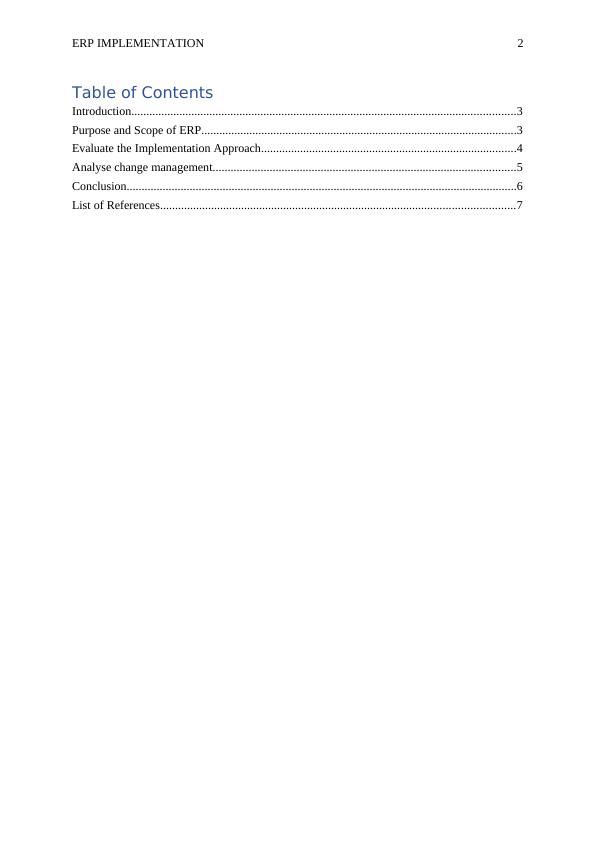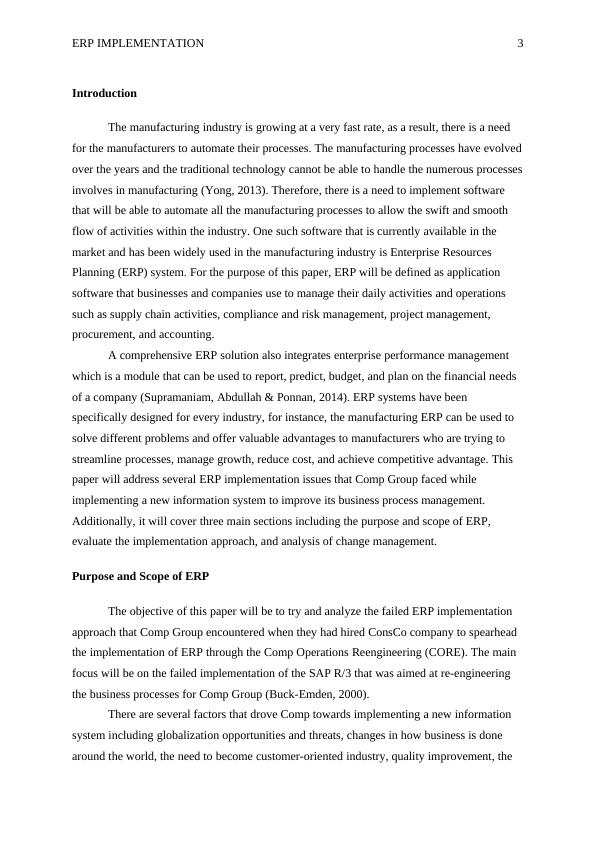ERP Implementation
Added on 2022-12-30
8 Pages2109 Words63 Views
ERP IMPLEMENTATION 1
ERP Implementation
Name
Course
Institution
Date
ERP Implementation
Name
Course
Institution
Date

ERP IMPLEMENTATION 2
Table of Contents
Introduction................................................................................................................................3
Purpose and Scope of ERP.........................................................................................................3
Evaluate the Implementation Approach.....................................................................................4
Analyse change management.....................................................................................................5
Conclusion..................................................................................................................................6
List of References......................................................................................................................7
Table of Contents
Introduction................................................................................................................................3
Purpose and Scope of ERP.........................................................................................................3
Evaluate the Implementation Approach.....................................................................................4
Analyse change management.....................................................................................................5
Conclusion..................................................................................................................................6
List of References......................................................................................................................7

ERP IMPLEMENTATION 3
Introduction
The manufacturing industry is growing at a very fast rate, as a result, there is a need
for the manufacturers to automate their processes. The manufacturing processes have evolved
over the years and the traditional technology cannot be able to handle the numerous processes
involves in manufacturing (Yong, 2013). Therefore, there is a need to implement software
that will be able to automate all the manufacturing processes to allow the swift and smooth
flow of activities within the industry. One such software that is currently available in the
market and has been widely used in the manufacturing industry is Enterprise Resources
Planning (ERP) system. For the purpose of this paper, ERP will be defined as application
software that businesses and companies use to manage their daily activities and operations
such as supply chain activities, compliance and risk management, project management,
procurement, and accounting.
A comprehensive ERP solution also integrates enterprise performance management
which is a module that can be used to report, predict, budget, and plan on the financial needs
of a company (Supramaniam, Abdullah & Ponnan, 2014). ERP systems have been
specifically designed for every industry, for instance, the manufacturing ERP can be used to
solve different problems and offer valuable advantages to manufacturers who are trying to
streamline processes, manage growth, reduce cost, and achieve competitive advantage. This
paper will address several ERP implementation issues that Comp Group faced while
implementing a new information system to improve its business process management.
Additionally, it will cover three main sections including the purpose and scope of ERP,
evaluate the implementation approach, and analysis of change management.
Purpose and Scope of ERP
The objective of this paper will be to try and analyze the failed ERP implementation
approach that Comp Group encountered when they had hired ConsCo company to spearhead
the implementation of ERP through the Comp Operations Reengineering (CORE). The main
focus will be on the failed implementation of the SAP R/3 that was aimed at re-engineering
the business processes for Comp Group (Buck-Emden, 2000).
There are several factors that drove Comp towards implementing a new information
system including globalization opportunities and threats, changes in how business is done
around the world, the need to become customer-oriented industry, quality improvement, the
Introduction
The manufacturing industry is growing at a very fast rate, as a result, there is a need
for the manufacturers to automate their processes. The manufacturing processes have evolved
over the years and the traditional technology cannot be able to handle the numerous processes
involves in manufacturing (Yong, 2013). Therefore, there is a need to implement software
that will be able to automate all the manufacturing processes to allow the swift and smooth
flow of activities within the industry. One such software that is currently available in the
market and has been widely used in the manufacturing industry is Enterprise Resources
Planning (ERP) system. For the purpose of this paper, ERP will be defined as application
software that businesses and companies use to manage their daily activities and operations
such as supply chain activities, compliance and risk management, project management,
procurement, and accounting.
A comprehensive ERP solution also integrates enterprise performance management
which is a module that can be used to report, predict, budget, and plan on the financial needs
of a company (Supramaniam, Abdullah & Ponnan, 2014). ERP systems have been
specifically designed for every industry, for instance, the manufacturing ERP can be used to
solve different problems and offer valuable advantages to manufacturers who are trying to
streamline processes, manage growth, reduce cost, and achieve competitive advantage. This
paper will address several ERP implementation issues that Comp Group faced while
implementing a new information system to improve its business process management.
Additionally, it will cover three main sections including the purpose and scope of ERP,
evaluate the implementation approach, and analysis of change management.
Purpose and Scope of ERP
The objective of this paper will be to try and analyze the failed ERP implementation
approach that Comp Group encountered when they had hired ConsCo company to spearhead
the implementation of ERP through the Comp Operations Reengineering (CORE). The main
focus will be on the failed implementation of the SAP R/3 that was aimed at re-engineering
the business processes for Comp Group (Buck-Emden, 2000).
There are several factors that drove Comp towards implementing a new information
system including globalization opportunities and threats, changes in how business is done
around the world, the need to become customer-oriented industry, quality improvement, the

End of preview
Want to access all the pages? Upload your documents or become a member.
Related Documents
Enterprise Systemlg...
|7
|1412
|32
Enterprise Systems: ERP Implementation Case Study Analysislg...
|6
|2232
|205
A Case Study Analysis of Enterprise Resource Planninglg...
|4
|1720
|49
ERP Implementation Failure at Comp Grouplg...
|10
|2216
|438
Re-engineering in Business | Case Studylg...
|5
|1398
|164
Case Study of Enterprise Resource Planninglg...
|8
|1512
|28
